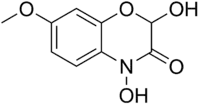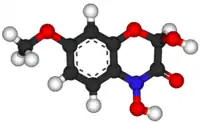DIMBOA
DIMBOA (2,4-dihydroxy-7-methoxy-1,4-benzoxazin-3-one) is a naturally occurring hydroxamic acid, a benzoxazinoid. DIMBOA is a powerful antibiotic present in maize, wheat, and related grasses,[1]
 | |
 | |
| Names | |
|---|---|
| IUPAC name
2,4-Dihydroxy-7-methoxy-1,4-benzoxazin-3-one | |
| Identifiers | |
3D model (JSmol) |
|
| ChemSpider | |
PubChem CID |
|
| UNII | |
CompTox Dashboard (EPA) |
|
| |
| |
| Properties | |
| C9H9NO5 | |
| Molar mass | 211.173 g·mol−1 |
Except where otherwise noted, data are given for materials in their standard state (at 25 °C [77 °F], 100 kPa). | |
| Infobox references | |
DIMBOA was first identified in maize in 1962 as the "corn sweet substance".[2] Etiolated maize seedlings have a very sweet, almost saccharin-like taste due to their high DIMBOA content.
DIMBOA is stored as an inactive precursor, DIMBOA-glucoside, which is activated by glucosidases in response to insect feeding,[1]
In maize, DIMBOA functions as natural defense against European corn borer larvae,[3][4] beet armyworms (Spodoptera exigua),[5] corn leaf aphids (Rhopalosiphum maidis),[6] other damaging insect pests, and pathogens, including fungi and bacteria.[1][7][8] The exact level of DIMBOA varies between individual plants,[9][10] but higher concentrations are typically found in young seedlings and the concentration decreases as the plant ages.[11] Natural variation in the Bx1 gene influences the DIMBOA content of maize seedlings.[9][12] In adult maize plants, the DIMBOA concentration is low, but it is induced rapidly in response to insect feeding.[13]
In addition to serving as a direct defensive compound due to its toxicity, DIMBOA can also function as a signaling molecule, leading to the accumulation of callose in response to treatment with chitosan (a fungal elicitor) and aphid feeding.[10] [14]
DIMBOA can also form complexes with iron in the rhizosphere and thereby enhance maize iron supply. [15]
Specialized insect pests such as the western corn rootworm can detect complexes between DIMBOA and iron and use these complexes for host identification and foraging. [15]
References
- Niemeyer HM (1988). "Hydroxamic acids (4-hydroxy-1,4-benzoxazin-3-ones), defence chemicals in the gramineae". Phytochemistry. 27 (11): 3349–3358. doi:10.1016/0031-9422(88)80731-3.
- Hamilton RH, Bandurski RS, Reusch WH (1962). "Isolation and characterization of a cyclic hydroxamate from Zea mays". Cereal Chemistry. 39: 107–113.
- G7113 European Corn Borer: A Multiple-Crop Pest in Missouri, MU Extension
- Klun JA, Guthrie WD, Hallauer AR, Russell WA (1970). "Genetic Nature of the Concentration of 2,4-dihydroxy-7-methoxy 2H-l,4-benzoxazin- 3(4H)-one and Resistance to the European Corn Borer in a Diallel Set of Eleven Maize Inbreds1". Crop Science. 10 (1): 87–90. doi:10.2135/cropsci1970.0011183X001000010032x.
- Tzin V, Hojo Y, Strickler SR, Bartsch LJ, Archer CM, Ahern KR, et al. (July 2017). "Rapid defense responses in maize leaves induced by Spodoptera exigua caterpillar feeding". Journal of Experimental Botany. 68 (16): 4709–4723. doi:10.1093/jxb/erx274. PMC 5853842. PMID 28981781.
- Betsiashvili M, Ahern KR, Jander G (February 2015). "Additive effects of two quantitative trait loci that confer Rhopalosiphum maidis (corn leaf aphid) resistance in maize inbred line Mo17". Journal of Experimental Botany. 66 (2): 571–8. doi:10.1093/jxb/eru379. PMC 4286405. PMID 25249072.
- Meihls LN, Kaur H, Jander G (2012). "Natural variation in maize defense against insect herbivores". Cold Spring Harbor Symposia on Quantitative Biology. 77: 269–83. doi:10.1101/sqb.2012.77.014662. PMID 23223408.
- Jackson D (2009). "Vegetative Shoot Meristems". In Bennetzen JL, Hake SC (eds.). Handbook of Maize: Its Biology. Springer New York. pp. 1–12. doi:10.1007/978-0-387-79418-1_1. ISBN 9780387794174.
- Butrón A, Chen YC, Rottinghaus GE, McMullen MD (February 2010). "Genetic variation at bx1 controls DIMBOA content in maize". TAG. Theoretical and Applied Genetics. Theoretische und Angewandte Genetik. 120 (4): 721–34. doi:10.1007/s00122-009-1192-1. hdl:10261/24875. PMID 19911162.
- Meihls LN, Handrick V, Glauser G, Barbier H, Kaur H, Haribal MM, et al. (June 2013). "Natural variation in maize aphid resistance is associated with 2,4-dihydroxy-7-methoxy-1,4-benzoxazin-3-one glucoside methyltransferase activity". The Plant Cell. 25 (6): 2341–55. doi:10.1105/tpc.113.112409. PMC 3723630. PMID 23898034.
- Cambier V, Hance T, de Hoffmann E (January 2000). "Variation of DIMBOA and related compounds content in relation to the age and plant organ in maize". Phytochemistry. 53 (2): 223–9. doi:10.1016/S0031-9422(99)00498-7. PMID 10680175.
- Zheng L, McMullen MD, Bauer E, Schön CC, Gierl A, Frey M (July 2015). "Prolonged expression of the BX1 signature enzyme is associated with a recombination hotspot in the benzoxazinoid gene cluster in Zea mays". Journal of Experimental Botany. 66 (13): 3917–30. doi:10.1093/jxb/erv192. PMC 4473990. PMID 25969552.
- Maag D, Köhler A, Robert CA, Frey M, Wolfender JL, Turlings TC, et al. (December 2016). "Highly localized and persistent induction of Bx1-dependent herbivore resistance factors in maize". The Plant Journal. 88 (6): 976–991. doi:10.1111/tpj.13308. PMID 27538820.
- Ahmad S, Veyrat N, Gordon-Weeks R, Zhang Y, Martin J, Smart L, et al. (September 2011). "Benzoxazinoid metabolites regulate innate immunity against aphids and fungi in maize". Plant Physiology. 157 (1): 317–27. doi:10.1104/pp.111.180224. PMC 3165881. PMID 21730199.
- Hu, L.; Mateo, P.; Ye, M.; Zhang, X.; Berset, J. D.; Handrick, V.; Radisch, D.; Grabe, V.; Köllner, T. G. (2018-08-17). "Plant iron acquisition strategy exploited by an insect herbivore". Science. 361 (6403): 694–697. Bibcode:2018Sci...361..694H. doi:10.1126/science.aat4082. ISSN 0036-8075. PMID 30115808.